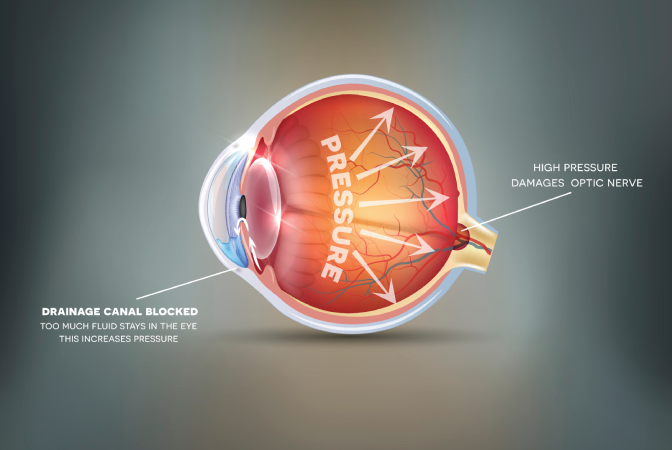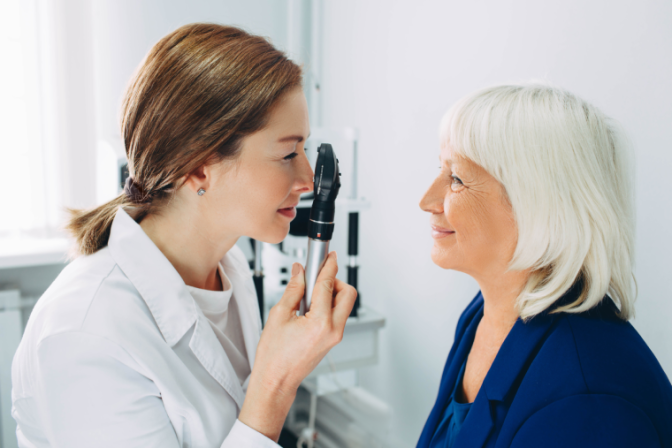Buy one pair of eyeglasses, get a second pair 50% off!
*Restrictions apply. Click here for details.
Find Glaucoma Care Near You

Glaucoma is the leading cause of irreversible blindness in the world. This group of eye conditions is commonly referred to as “the silent thief of sight” because the symptoms develop slowly and often go unnoticed. Many patients suffering from glaucoma lose up to 40% of their vision before realizing there is a problem.
Routine eye exams allow the team at Clarkson Eyecare to detect eye disease and other eye conditions before vision loss or impairment occurs. Although glaucoma cannot be prevented, it can be controlled and managed with the right treatments. Our doctors specialize in glaucoma care and will help you maintain the best vision possible.
Protect your gift of sight and schedule an appointment with one of our glaucoma specialists today.
Schedule a Glaucoma Exam at Clarkson Eyecare Today

Over 40? It is recommended to have a glaucoma exam every 3-4 years. Higher risk populations, especially those with a family history, should be examined for glaucoma more regularly. Clarkson Eyecare has experienced eye doctors practicing in Ohio, Illinois, Texas, Missouri, Michigan, Texas, Florida, Kentucky, Virginia, Georgia, and New Jersey specializing in Glaucoma care. Schedule a glaucoma exam at your nearest Clarkson Eyecare to preserve your sight.
What is Glaucoma?
Glaucoma most often affects people over 40 years old, occurring when your eye cannot maintain a balance between the amount of intraocular fluid produced and drained. Intraocular fluid maintains the shape of your eye and flows between the iris and the lens.
When there is an imbalance, the pressure in your eye increases. Too much pressure causes damage to the optic nerve, the part of the eye that is responsible for sending the images you see to the brain, causing changes to your vision.
What is the Most Common Cause of Glaucoma?
While less common, glaucoma can also be caused by blunt or chemical eye injuries, a severe infection, blocked blood vessels, and inflammatory conditions. Glaucoma can be hereditary and passed on from parents to children.
Types of Glaucoma
Glaucoma develops in the eye when there is a decrease in blood flow to the optic nerve or increased pressure to the individual nerve fibers. There are two main types of the disease. Open Angle Chronic Glaucoma occurs when fluid fails to flow out of the eye as it should. Acute Angle Closure Glaucoma, generally linked to patients who are farsighted or have cataracts, occurs when the drainage space between the iris and cornea is too narrow, causing a build up of pressure. Other forms of glaucoma include:
Congenital Glaucoma
This type of glaucoma occurs when the drainage canals are undeveloped and is present at birth. Congenital glaucoma occurs in babies during the prenatal period and, while rare, usually shows symptoms right away. Surgery is an effective way to prevent vision loss if completed early in the child’s life.
Open-Angle Glaucoma
This form of glaucoma is the most common type in the United States, with 9 out of 10 Americans with glaucoma experiencing open-angle. While the precise cause of open-angle glaucoma is unknown, intraocular fluid doesn’t efficiently drain from the eye, causing an increase in intraocular pressure.
Normal-Tension Glaucoma
Unlike other types of glaucoma, normal-tension glaucoma typically appears in those who have normal intraocular pressure but still experience optic nerve damage. Low blood pressure, heart problems, and abnormal heart rhythms increase the risk of normal-tension glaucoma.
Angle-Closure Glaucoma
Also known as narrow-acute or acute glaucoma, this form of the disease is considered a medical emergency and requires immediate treatment to avoid blindness. Angle-closure glaucoma develops when the edge of your iris blocks fluid from draining, causing the fluid to build up in the eye and increase intraocular pressure.
Secondary Glaucoma
Secondary glaucoma encompasses the several other types of glaucoma that develop as a result of other medical conditions or treatments. This form is caused by eye injury, inflammation, certain drugs, and advanced cases of cataracts or diabetes. Some examples of secondary glaucoma include neovascular glaucoma, pigmentary glaucoma, exfoliation glaucoma, and uveitic glaucoma.
Risk Factors for Glaucoma
While age is the most common cause of glaucoma, it can affect anyone, including infants, children, and young adults. Risk factors include:
African American, Irish, Russian, Japanese, Hispanic, Inuit, or Scandinavian descent
Over 40
A family history of glaucoma
Nearsighted or farsighted
Poor or blurred vision
Diabetes
Steroid medications such as prednisone
Medications for bladder control or seizures, or some over-the-counter cold remedies
Previous eye injuries
Thin corneas
High blood pressure, heart disease, diabetes, or sickle cell anemia
High eye pressure
How to Prevent Glaucoma

Glaucoma cannot be cured, making it vital to visit your eye doctor as soon as possible to prevent vision loss and preserve your sight.
Routine eye exams are the best way for you and your family to fight against glaucoma. At Clarkson Eyecare, we treat patients of all ages across the United States and work together to ensure your eyes are as healthy as possible.
How is Glaucoma Detected?
A regular eye exam is the best way to detect glaucoma. Clarkson Eyecare’s glaucoma doctors use a combination of tests to determine your diagnosis.
Tonometry exams measure eye pressure, while gonioscopy exams inspect drainage angles. An ophthalmoscopy examines your optic nerve, and perimetry testing tests the visual field of each eye. Completing each of these tests may not be necessary for every person, but they can be used together to diagnose or rule out glaucoma.
Understanding Your Glaucoma Treatment Options
If you are diagnosed with glaucoma or suspect you have the disease, the team at Clarkson Eyecare can help identify the right treatment option for you.
Ultimately, your glaucoma treatment depends on the type and severity of the diagnosis and the stage at which glaucoma was detected in. While glaucoma cannot be cured, it can be managed with the right treatments. Treatment options for glaucoma include:
Medications & Eye Drops
Your Clarkson Eyecare glaucoma doctor may prescribe medications or eye drops to lower eye pressure and prevent optic nerve damage in patients with glaucoma. While these eye drops can’t cure glaucoma or reverse the vision loss it has already caused, they can prevent the condition from worsening.
Laser Surgeries
Glaucoma laser surgeries help lower the intraocular pressure in the eye by making a small hole for fluid to drain from or inserting a small drain to help move fluid out of your eye. When determining if laser surgery is right for you, your eye doctor will consider the type of laser surgery, the type of glaucoma, age, race, and many other factors.
Operative Surgeries
If glaucoma medicines or laser treatment haven’t helped to control your glaucoma, your doctor may recommend surgery. Trabeculectomy, glaucoma implant surgery, and minimally invasive glaucoma surgery (MIGS) can help lower the pressure in your eye and prevent your glaucoma from worsening.
Frequently Asked Questions About Glaucoma
While glaucoma is rare in children, it can occur and is often hereditary. Glaucoma in children happens during the prenatal period when their drainage canals do not fully develop. Most children with glaucoma are diagnosed before they turn 6 months old.
If you feel your child’s vision is impaired, trust the team at Clarkson Eyecare to deliver the personalized care your loved one needs and deserves.
Glaucoma is the leading cause of irreversible blindness if left untreated. Of about 2.3 million cases of glaucoma, 12 percent have resulted in vision impairment and approximately 120,000 in complete loss of sight.
Routine eye exams are essential to eye health because they allow your doctor to monitor your vision, detect eye conditions like glaucoma, and provide treatment to manage the progression of the disease. Visiting your eye doctor regularly and completing an eye exam as soon as possible can prevent your glaucoma from worsening and preserve your remaining vision.
While there are no known ways to prevent glaucoma, blindness or significant vision loss can be prevented with early-stage recognition and intervention. Primary angle glaucoma, the most common form of the condition, is highlighted by silent, slow, and progressive vision loss.
If you are at risk for glaucoma, you should see an ophthalmologist at Clarkson Eyecare for regular exams. This can catch the disease in its early stages and allow for it to be treated before it leads to complete vision loss.
At Clarkson Eyecare, we recommend routine, comprehensive eye exams for the whole family to ensure you are experiencing the best vision possible at every stage of life.
Your eye doctor may recommend yearly exams if you’re over 40 years of age or have any of the traits that put you at a higher risk for glaucoma.
Glaucoma causes a gradual loss of peripheral vision. The most common symptoms reported by patients with early and moderate-stage glaucoma are needing more light, blurry vision, and seeing a glare. Those with glaucoma may initially notice having a harder time with tasks that require visual attention, such as reading and driving. If you notice these early warning signs, visit your eye doctor as soon as possible to diagnose or rule out the possibility of glaucoma.
This varies based on the type and degree of glaucoma you have. You may need to visit your eye doctor every three months or every year, but if your eye doctor is concerned about your progression, visits may occur more regularly to ensure your vision is preserved.
The best way to test for glaucoma is through a comprehensive eye exam with an ophthalmologist. These tests evaluate your drainage angle and optic nerve with dilation. A visual field test and optic nerve photograph or analysis may be performed to gain a more comprehensive picture of your eye health.
Schedule a Glaucoma Exam at Clarkson Eyecare Today

Early detection of glaucoma is essential, as symptoms often go unnoticed in the early stages. Additionally, once vision loss occurs, it cannot be reversed. If you are at risk for glaucoma, you should see your eye doctor regularly to monitor your eye health and maintain your vision. If you or a loved one is experiencing symptoms or at risk for glaucoma, schedule an appointment with Clarkson Eyecare today.
